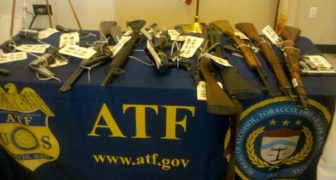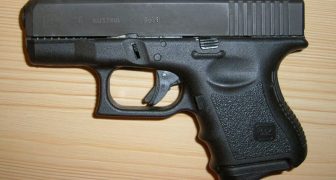by Home Defense Gun staffer Pat

What not to do!
When I began teaching CCW and defensive handgun courses, I quickly realized a couple things about using other people’s ranges for my classes. The first thing was that if I wanted to ensure being able to do things in my time and on my schedule, I was going to have to do something different. The second thing was that if I was going to keep costs down for my students, I was going to have to do something different!
So, the idea quickly took shape to build a pistol range at my place, and the first natural step was to add an RSO (Range Safety Officer) rating to my credentials. The NRA’s RSO course provided a lot of good information on setting up and running a shooting range, and got me off on the right foot. If you are just looking for a place for yourself, family, and friends to stay sharp you could skip this step, but if you can swing it I highly recommend getting this rating.
The first thing you will have to look into is if shooting is permitted by law on your property. This could be a problem if you live in town but is most likely a non-issue if you live on or have access to rural acreage.The second thing you will have to determine is what kind of shooting you will be doing. Obviously, a rifle range will require a lot more space and more formidable background than a pistol or tactical shotgun range. In my case, I wanted to teach basic pistol, CCW, home and personal defense, I opted to build my range around pistol and light tactical shotgun parameters. This meant that for CCW and other handgun shooting I would base things on the 7 yard scale required by my state’s CCW training requirements, but that I wanted the flexibility to use shotguns at ranges out to 25 yards. This defined the length of my range.
Next, you will need to decide how many shooters you want to accommodate on your firing line at a time. NRA protocols allow 10 Shooters per RSO, while state CCW training guidelines permit no more than 5 on the line. I opted to go with the state, and so my range consists of five lanes. My lanes are each 10 feet wide to cut down on the number of spent casings from your neighbor’s weapon bouncing off your head during exercises. This defines the width of my range.
Once you know your dimensions, you can select your site. The biggest consideration here is to have a good, bullet stopping background across the width of your range. In my case, I chose a spot with a tenth of a mile of dense woods stretching from the back of the range to my property line. If you lack a feature like this, or a natural hill to put your range in front of, a couple dump truck loads of cheap fill will make a nice berm to shoot against. Make sure the fill isn’t too rocky to avoid ricochets.
Now for the target stands. I have come up with a simple design, made from PVC pipe that makes a great portable stand. PVC is awesome because it is cheap, easy to work with, and easy to repair.
For each stand you will need:1) 30 feet (3 sticks) of ¾ inch schedule 40 PVC
2) 6 ¾ inch 90s
3) 4 ¾ inch Ts
4) 1 2’ X 3’ piece of plywood
5) 8 Cable tiesYou will also need a tape measure and PVC cutter or a Hacksaw, and a drill. Each stand consists of a base and an upright. The bas is 2’ X 6’ and the upright is 2’ X 5’. The cutting list is:
1) 4 3’ pieces for the base
2) 2 2’ foot pieces for the base
3) 2 2’ foot uprights
4) 2 3’ uprights5) 2 2’ cross members for the upright
For the base, join two of the 3’ sections with a T and place a 90 on each end. Repeat this step. Next, tie these pieces together at both ends by placing a two’ section between the 90s forming a large rectangle. Be sure that the remaining sockets of the Ts are pointed up, and insert your 2’ uprights into these Ts. Place another T on top of each of these and insert a 3’ section into the tops of each of these. Join the two uprights by putting a 2’ section between the Ts and by placing a 90 on top of each of your 3’ uprights and join these with your remaining 2’ section.
On your plywood, drill two small holes on each side about an inch in from the edge and about 3 inches from the corners. Put a cable tie through each hole, and use these to hang the plywood between the top (3’) sections of your uprights. This will provide a backing to staple targets to.
You are now done building a target stand! Please notice that at no point did I mention PVC cement. This was NOT an oversight! Here is why- the PVC pipes will get shot from time to time. I don’t know why this is inevitable but trust me it is! If your pipes and fittings are glued together, a single broken pipe ruins the whole thing. With no glue involved, broken pieces are easy to replace. Not gluing also allows you to take the stands down for storage or transportation. I have found, the hard way, that it is not a good idea to leave these stands up when not in use. They can be damaged by high winds and by itchy horses. Once again I have no idea why, but when horses get itchy they think that the only way to solve the problem is to rub against anything you don’t want them to! My first set of stands sustained both wind and horse damage. So now I remove the uprights from the bases and lay them down between sessions. I weight the bases with sand bags for additional stability on windy days.
The final step in range construction is to define the space. For this I use bright orange surveyors marking paint. First, I paint in a straight line the width of the back of the range and space my target stands properly along this line. I then measure off the back line to establish the firing line, at the proper range for the day’s activities, and paint this in the width of the range. I then make a third line, measured back 6 feet off the firing line. The space between the firing line and the back line is my “hot box”, the only place where weapons are fired or even loaded. Finally I paint in the side lines to finish out the definition of the shooting space.If you have the room and a safe location, and if local laws permit, a home shooting range is a big time and money saver. Building one is fairly economical, and having 24/7 access will allow you to brush up on your skills when you have a few minutes but not enough time to pack up and head over to your local range. Practice is the key to proficiency and the easier it is for you to practice the more you will do it.
Even if you can’t have a range at your place, the PVC target stands make a lot of sense. They are easily stowed in your vehicle if you are heading to a friend or relatives country place, or to public lands where shooting is permitted. Having a convenient and secure place to hang your targets will enhance your shooting experience and allow you to make the most of whatever shooting time you have.
Always be safe and courteous in your shooting. Don’t conduct massive live fire events after midnight if your neighbors are within hearing distance! Also, when setting up at home or away, remember what that booklet that came with your first Daisy BB gun said- don’t just know your target, but what is beyond your target. Bullets don’t stop at the end of your range unless you make them.
Happy Shooting!


Speak Your Mind